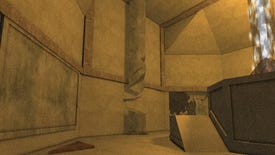Wot I Think: Kairo
Don't you dare compare it to Myst.
Richard Perrin's atmospheric puzzle explorer Kairo reaches Steam tomorrow, so now seemed a good moment to give it a proper Wot I Think. So, er, here's wot I think:
Kairo is a beautiful thing. And the key word here is "thing". You could, I suppose, boil it down to being a first-person puzzle game. But that misses the entirety of what Kairo is. You could recognise it as an ambiguous piece of art, but that doesn't recognise how precise and careful it is. So I have settled for "thing". A beautiful one.
However you might describe it, the word "enigmatic" applies to every element. Made up of dozens of interlinked locations, yawning rooms of extraordinary architecture, or tight, reality-defying tunnels and bunkers, your purpose in Kairo is never explained, nor indeed does it ever feel important. It's a game about exploring spaces, and finding out the consequences of your exploration, driven by a vague notion of progression. Success is measured in slight changes to the environments, these minuscule adjustments feeling oddly significant, as you eventually have done enough to open up new areas, and further explore.
Kairo is, in a large part, about an ambiguous exploration of your physical presence in the world. The puzzles themselves maintain this depth of ambiguity. Each room, distinctly coloured and uniquely designed, has something you must do. What it is, and how you relate your actions to it, is perhaps the core of the game. Sometimes it's as simple as pushing a block into a hole. At other times you're realising that your movement is determining the rotation of objects within the world, and you must manipulate them accordingly. Even when a puzzle is about pattern recognition, or manipulating buttons, it's still very much about your tangible connection to the world. Buttons are large tiles that must be trodden on, or huge sections of three-storey walls that must be ascended into order to push them.
Sound also plays a very significant role. In a game that asks you to go through such a relatively barren experience it had to be perfect, and it is. Objects bong and ding in a way that sends you equivocal messages, nudges in the right direction, or simply sing to you as you go by. There's also radio static, peculiar coded messages emanating from structures, and odd voices, all leaning toward the game's hinted messages of technology.
I'm aware that these aren't very coherent descriptions. That's because they're describing something particularly incoherent. Quite what Kairo is about entirely eludes me, and yet I never felt alienated from its themes. Strands of DNA, fuzzy images of Da Vinci's Vitruvian Man, and photos of Einstein speak of scientific and technological progress, while barely discernible images of devastation, ruined towns, and ghostly figures seem to suggest somewhat more negative thoughts. But just putting those things in a sentence is far too big of a misrepresentation - these are scattered images, appearing in odd frames on some walls, or sometimes peculiarly appearing walls of fuzzing video.
Much of what you do is driven by symbols - symbols that might be part of some unknown numbering system. Understanding their patterns is only occasionally important, but they add a sense of thematic consistency to each of what you eventually recognise as the game's four areas. It's details like this that demonstrate just how much thought has gone into Kairo, alongside the more immediately obvious passion behind its architecture.
And what architecture. While the game is unquestionably basic in its building materials - bland, geometric shapes, with only a few repeated textures - their construction is superb. Elaborate staircases wind up sloping walls in huge temples that look like a tribute to an alien Masonry. Huge open plains stretch to the horizon, where new structures await, that when finally reached are towering castles of madness. Elsewhere you might be walking along floating paths that construct themselves before you, or negotiating winding pathways built of hundreds of varying cubes. One particular room features a maze whose walls only crash into place when you approach them, before just showing you an empty chamber. The ceaseless inventiveness of its ever-different constructions is by far the most deserving element for celebration.
Things perhaps get a little wayward in the final quarter. The last section is appropriately more difficult, but unfortunately pushes the ambiguity a little too far, perhaps leaving you lost for where to go next. It was at this point that I discovered that there's a hint system, however, in the the Pause menu. While I'd prefer the game to have never needed one in the first place, it did see me through these confusing last few moments. It's definitely welcome that things become more spread out, less linear, in this area, but when one of the apparent puzzles proves not to be a puzzle at all (unless you've discovered a secret quest that I had missed) it lies there like a red herring, making you feel sure you've missed something and all the ensuing frustration. (The hints make it clear not to worry about it, but like I say, it probably shouldn't have needed the hints to do that.)
Overall, Kairo is quite the thing. A wonderful piece of explorable, challenging artistry, a stunning collection of esoteric architecture, and a delightfully peculiar journey.
Kairo is out on Steam tomorrow, and available now for $8 via a Humble Store on Perrin's site.
















